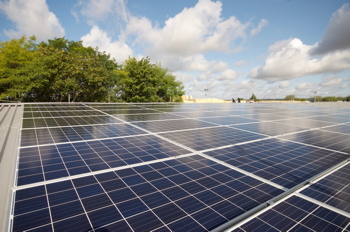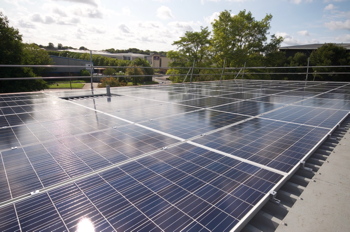Proving the value of renewables

Installations of renewable energy generation have been declining month on month since February 2016. One of the main reasons behind the decline is due to a lack of understanding and inability to evaluate the feasibility of all renewable options available to a specific building.
The latest renewables update from the Department for Business, Energy & Industrial Strategy (BEIS) revealed that cumulative capacity on nondomestic properties had grown by just 10% in the last year – down from the previous growth rate of nearly 60% the year before. The decline in installations means that fewer commercial properties are adopting renewables, preventing the UK from reaching its carbon reduction targets.
Data evidence
The decision matrix for a renewable project is a complex one and data collection is absolutely crucial to this. There are two strands of building data on which to focus, Energy Performance Certificates (EPC) and consumption data.
EPC data provides a simplified model of the energy efficiency of the structure and equipment, and the likely consumption relative to other buildings of the same type. It can highlight simple and effective measures to reduce the energy demand of the building that should be considered before investing in renewable technology.
Improvements in metering means that half hourly data is much more common and enables much more accurate calculation of savings. An understanding of where and when you are consuming energy as well as where and when it is being wasted informs the renewable decision making process.
Data metering also helps to understand the profile of consumption, allowing for analysis across set time frames. Solar photovoltaics (PV) for example would work well on buildings that have high electricity consumption throughout the summer in daylight hours, such as a shopping centre, but would be pointless on a nightclub.
This ‘internal’ building data must be combined with other important elements when considering what renewable technologies to select. Location can be crucial. For example, on paper, a biomass plant may look like a feasible option but if the closest source of wood chip and pellets is 200 miles away, it suddenly isn’t the low carbon option it appeared to be.
 |
The site’s latitude directly relates to the potential solar energy generation; the closer you are to the equator the higher the solar irradiation, and the lower the optimum inclination for PV panels. In the UK, Aberdeen will receive around 900 kWh/ m2 per annum, whereas down in Cornwall this can exceed 1200 kWh/m2.
Barriers to progress
To analyse wind power, assessments of wind potential and other local structures need to be made, alongside the turbine’s height and rated power, all of which significantly impact power generation.
The barrier to renewables most often quoted is access to finance and capital, however we are seeing more and more creative approaches to finance helping to unlock renewable projects through energy savings payback.
Another barrier is the lack of confidence in the longevity of renewables policy, not helped in the least by Brexit. There has been a perception that the cost of solar PV has been steadily decreasing over the last few years so organisations decide to postpone projects in the hope it will be significantly cheaper to install the following year.
The cost of installations may fluctuate and reduce by small percentages year on year, but much more significant is the cost of electricity. Electricity prices have been rising by 6-10% annually in the last ten years and there is no particular reason to think this will change. It is these rising costs that can mean renewable projects determined to be non-via two years ago are now adding up financially.
Making decisions
Good data, which provides a solid base for business decision making can make all the difference when deciding to use renewable technologies. The challenge is to be able to bring this data together in usable and understandable format.
Building modelling firm arbnco has launched its software arbn renew which can bring together this data to provide a first-stage feasibility study for the deployment of a whole range of renewable energy systems, based on location, geometry and consumption of heat and power.
The software aligns the cost of renewable projects with fluctuating energy prices, enabling a decision to be made based on the most current calculations. It also tracks the latest Government grants available for each renewable project, another vital factor in determining the feasibility of a renewable installation.
There are usually a number of business decision makers involved in the process - anyone from the facilities manager to the chief financial officer (CFO) will have a say, and the knowledge and experience of those persons could vary enormously. Using data can also help remove bias, and remove any possibility of human error in any financial calculations.
 |
The arbnco software will provide the cold data and allow comparisons to be made across seven renewable options and against non-renewable options. If, for example, the most economical and lowest carbon solution is a high-efficiency gas boiler over a CHP plant then the software will present that and allow specifiers to make a dispassionate decision.
The go-ahead for huge capital projects such as renewables are more often than not made in the boardroom with the CFO having a large input on the final say. As such, the data needs to be presented in a format understandable to financial officers and C-suite level executives. The decision matrix on a renewable project must have net present value (NPV) and the internal rate of return (IRR) documented alongside recommended funding structure, revenue funding and capital expenditure.
Mission-critical
Ultimately, renewable projects shouldn’t be seen as a one-off decision. They need to be taken as a watching brief; the pace of technology and changes to the economy can impact the feasibility of a project overnight.
Data is mission-critical to the decision making process because it offers impartial information that can make a business case tailored for a particular project. This equips commercial real estate owners and managers with the information they need to make a decision on what combination of renewable technologies would be most beneficial.
Stephen Preece, is business development director at arbnco







